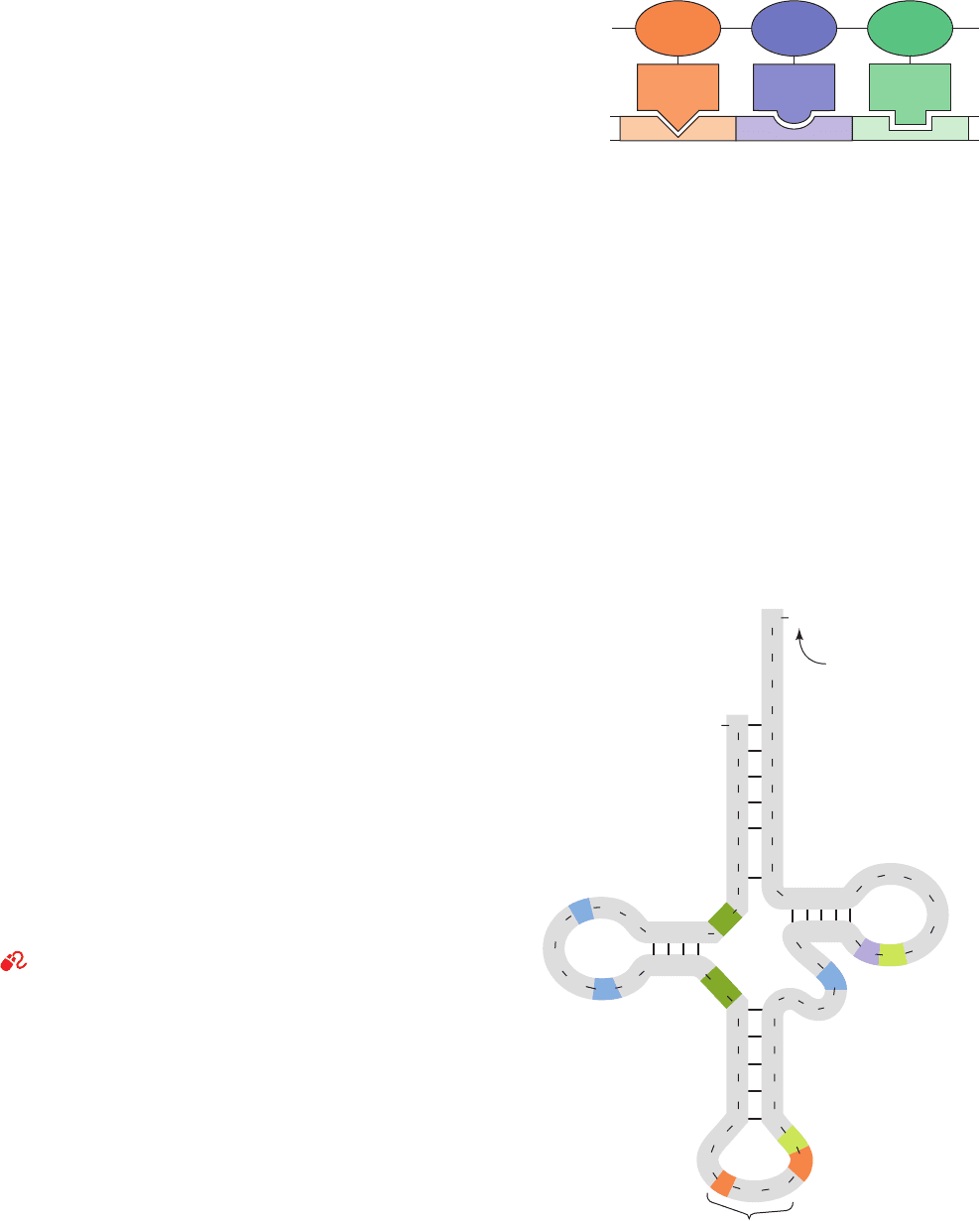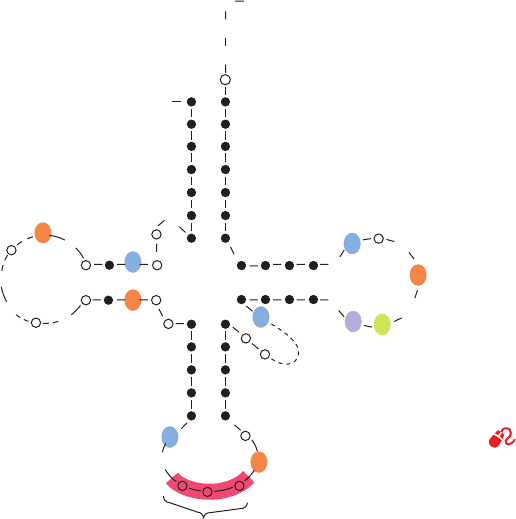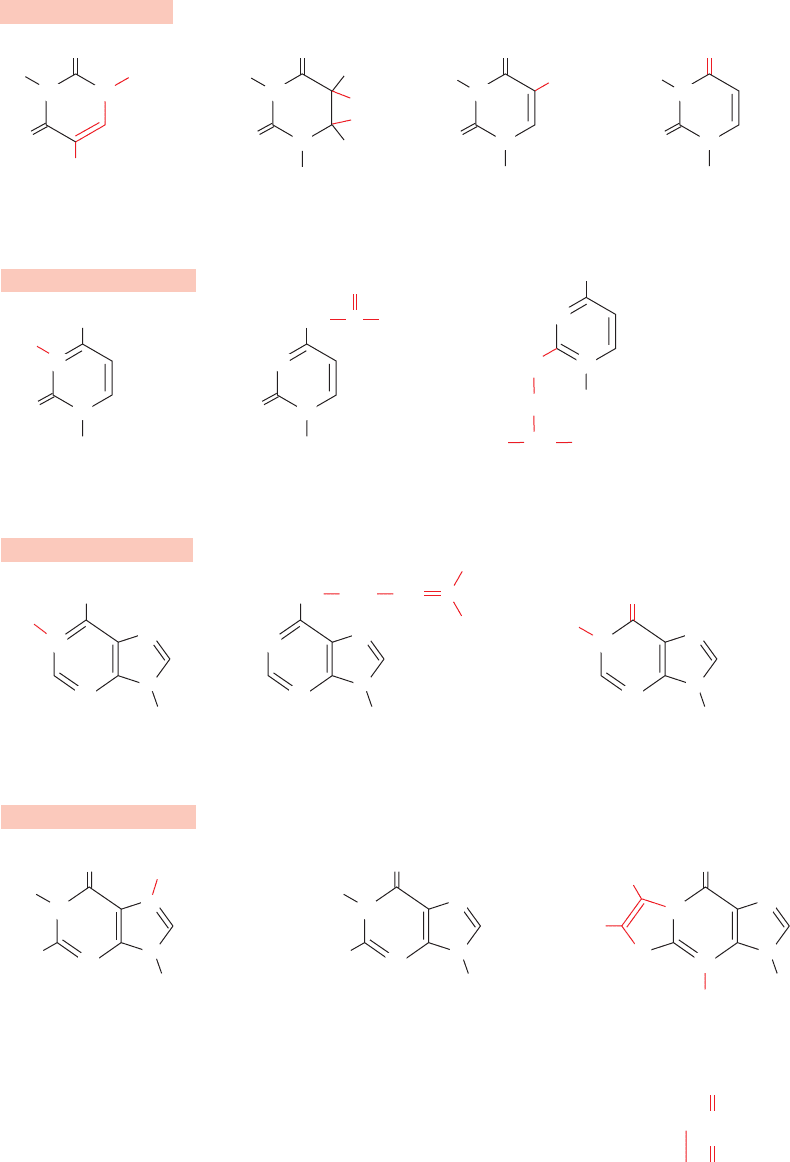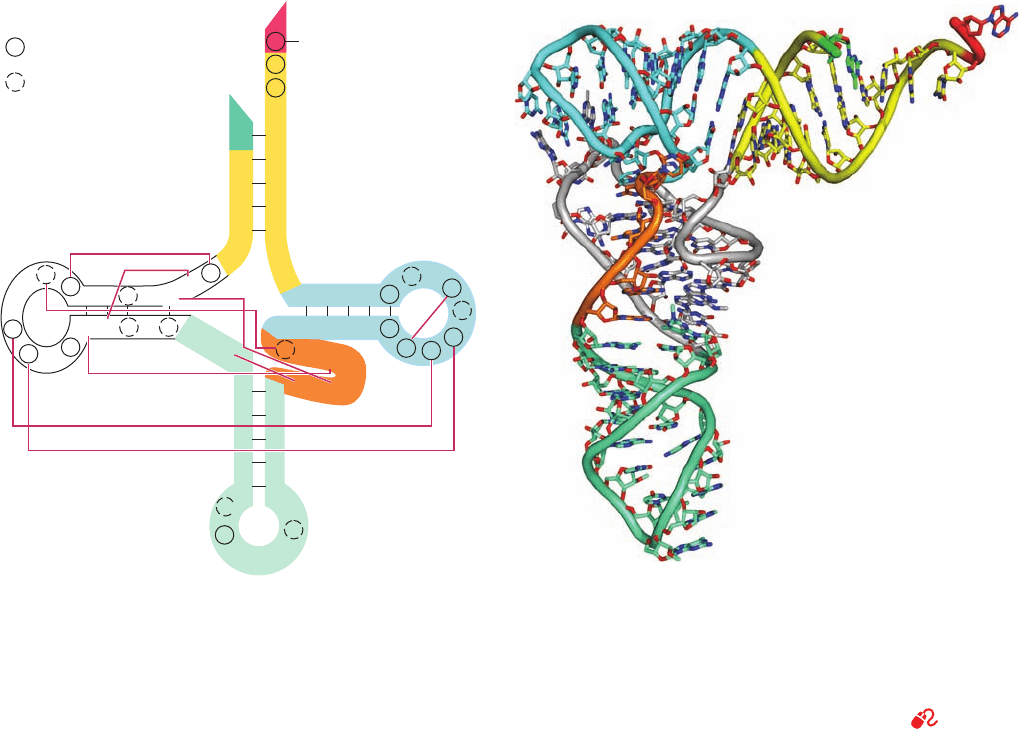Voet D., Voet Ju.G. Biochemistry
Подождите немного. Документ загружается.

2. The code is read in a sequential manner starting from
a fixed point in the gene. The insertion or deletion of a nu-
cleotide shifts the frame (grouping) in which succeeding
nucleotides are read as codons (insertions or deletions of
nucleotides are therefore also known as frameshift muta-
tions).Thus the code has no internal punctuation that indi-
cates the reading frame; that is, the code is comma free.
3. The code is a triplet code.
4. All or nearly all of the 64 triplet codons code for an
amino acid; that is, the code is degenerate.
These principles are illustrated by the following anal-
ogy. Consider a sentence (gene) in which the words
(codons) each consist of three letters (bases).
(Here the spaces separating the words have no physical sig-
nificance; they are only present to indicate the reading
frame.) The deletion of the fourth letter, which shifts the
reading frame, changes the sentence to
so that all words past the point of deletion are unintelligi-
ble (specify the wrong amino acids). An insertion of any
letter, however, say an X in the ninth position,
restores the original reading frame. Consequently, only the
words between the two changes (mutations) are altered.As
in this example, such a sentence might still be intelligible
(the gene could still specify a functional protein), particu-
larly if the changes are close together.Two deletions or two
insertions, no matter how close together, would not sup-
press each other but just shift the reading frame. However,
three insertions, say X, Y, and Z in the fifth, eighth, and
twelfth positions, respectively, would change the sentence to
which, after the third insertion, restores the original read-
ing frame. The same would be true of three deletions. As
before, if all three changes were close together, the sen-
tence might still retain much of its meaning.
Crick and Brenner did not unambiguously demonstrate
that the genetic code is a triplet code because they had no
proof that their insertions and deletions involved only single
nucleotides. Strictly speaking,they showed that a codon con-
sists of 3r nucleotides where r is the number of nucleotides in
an insertion or deletion. Although it was generally assumed
at the time that r 1, proof of this assertion had to await the
elucidation of the genetic code (Section 32-1C).
C. Deciphering the Genetic Code
The genetic code could, in principle, be determined by sim-
ply comparing the base sequence of an mRNA with the
amino acid sequence of the polypeptide it specifies. In the
1960s, however, techniques for isolating and sequencing
THE BXI GYR EDZ FOX ATE THE EGG
THE IGR EDX FOX ATE THE EGG
THE IGR EDF OXA TET HEE GG
THE BIG RED FOX ATE THE EGG
Section 32-1. The Genetic Code 1341
mRNAs had not yet been developed. The elucidation of
the genetic code dictionary therefore proved to be a diffi-
cult task.
a. UUU Specifies Phe
The major breakthrough in deciphering the genetic code
came in 1961 when Marshall Nirenberg and Heinrich
Matthaei established that UUU is the codon specifying Phe.
They did so by demonstrating that the addition of poly(U) to
a cell-free protein synthesizing system stimulates only the
synthesis of poly(Phe). The cell-free protein synthesizing
system was prepared by gently breaking open E. coli cells by
grinding them with powdered alumina and centrifuging the
resulting cell sap to remove the cell walls and membranes.
This extract contained DNA, mRNA, ribosomes, enzymes,
and other cell constituents necessary for protein synthesis.
When fortified with ATP, GTP, and amino acids, the system
synthesized small amounts of proteins. This was demon-
strated by the incubation of the system with
14
C-labeled
amino acids followed by the precipitation of its proteins by
the addition of trichloroacetic acid. The precipitate proved
to be radioactive.
A cell-free protein synthesizing system, of course, pro-
duces proteins specified by the cell’s DNA. On addition of
DNase, however, protein synthesis stops within a few min-
utes because the system can no longer synthesize mRNA,
whereas the mRNA originally present is rapidly degraded.
Nirenberg found that crude mRNA-containing fractions
from other organisms were highly active in stimulating pro-
tein synthesis in a DNase-treated protein synthesizing sys-
tem.This system is likewise responsive to synthetic mRNAs.
The synthetic mRNAs that Nirenberg used in subse-
quent experiments were synthesized by the Azotobacter
vinelandii enzyme polynucleotide phosphorylase. This en-
zyme, which was discovered by Severo Ochoa and Mari-
anne Grunberg-Manago, links together nucleotides in the
reaction
.
In contrast to RNA polymerase, however, polynucleotide
phosphorylase does not utilize a template. Rather, it ran-
domly links together the available NDPs so that the base
composition of the product RNA reflects that of the reac-
tant NDP mixture.
Nirenberg and Matthaei demonstrated that poly(U)
stimulates the synthesis of poly(Phe) by incubating
poly(U) and a mixture of 1 radioactive and 19 unlabeled
amino acids in a DNase-treated protein synthesizing sys-
tem. Significant radioactivity appeared in the protein pre-
cipitate only when phenylalanine was labeled. UUU must
therefore be the codon specifying Phe. In similar experi-
ments using poly(A) and poly(C), it was found that
poly(Lys) and poly(Pro), respectively, were synthesized.
Thus AAA specifies Lys and CCC specifies Pro. [Poly(G)
cannot function as a synthetic mRNA because, even under
denaturing conditions, it aggregates to form a four-
stranded helix (Section 30-4De).An mRNA must be single
stranded to direct its translation; Section 32-2D.]
(RNA)
n
NDP Δ (RNA)
n1
P
i
JWCL281_c32_1338-1428.qxd 8/4/10 4:44 PM Page 1341

Nirenberg and Ochoa independently employed ribonu-
cleotide copolymers to further elucidate the genetic code. For
example, in a poly(UG) composed of 76% U and 24% G, the
probability of a given triplet being UUU is 0.76 0.76 0.76
0.44. Likewise, the probability of a particular triplet con-
sisting of 2U’s and 1G, that is, UUG, UGU, or GUU, is 0.76
0.76 0.24 0.14. The use of this poly(UG) as an mRNA
therefore indicated the base compositions, but not the se-
quences, of the codons specifying several amino acids (Table
32-1). Through the use of copolymers containing two, three,
and four bases, the base compositions of codons specifying
each of the 20 amino acids were inferred. Moreover,these ex-
periments demonstrated that the genetic code is degenerate
since, for example, poly(UA), poly(UC), and poly(UG) all di-
rect the incorporation of Leu into a polypeptide.
b. The Genetic Code Was Elucidated through Triplet
Binding Assays and the Use of Polyribonucleotides
with Known Sequences
In the absence of GTP, which is necessary for protein
synthesis, trinucleotides but not dinucleotides are almost
as effective as mRNAs in promoting the ribosomal bind-
ing of specific tRNAs.This phenomenon, which Nirenberg
and Philip Leder discovered in 1964, permitted the various
codons to be identified by a simple binding assay. Ribo-
somes, together with their bound tRNAs, are retained by a
nitrocellulose filter but free tRNA is not. The bound
tRNA was identified by using charged tRNA mixtures in
which only one of the pendent amino acid residues was ra-
dioactively labeled. For instance,it was found, as expected,
that UUU stimulates the ribosomal binding of only Phe
tRNA. Likewise, UUG, UGU, and GUU stimulate the
binding of Leu, Cys, and Val tRNAs, respectively. Hence
UUG, UGU, and GUU must be codons that specify Leu,
Cys, and Val, respectively. In this way, the amino acids
specified by some 50 codons were identified. For the re-
maining codons, the binding assay was either negative (no
tRNA bound) or ambiguous.
The genetic code dictionary was completed and previ-
ous results confirmed through H. Gobind Khorana’s syn-
thesis of polyribonucleotides with specified repeating se-
quences (Section 7-6A). In a cell-free protein synthesizing
system, UCUCUCUC, for example, is read
so that it specifies a polypeptide chain of two alternating
amino acid residues. In fact, it was observed that this
mRNA stimulated the production of
which indicates that either UCU or CUC specifies Ser and
the other specifies Leu.This information, together with the
tRNA-binding data, permitted the conclusion that UCU
codes for Ser and CUC codes for Leu. These data also
prove that codons consist of an odd number of nucleotides,
thereby relieving any residual suspicions that codons con-
sist of six rather than three nucleotides.
Alternating sequences of three nucleotides, such as
poly(UAC), specify three different homopolypeptides be-
cause ribosomes may initiate polypeptide synthesis on
these synthetic mRNAs in any of the three possible read-
ing frames (Fig. 32-5). Analyses of the polypeptides speci-
fied by various alternating sequences of two and three nu-
cleotides confirmed the identity of many codons and filled
out missing portions of the genetic code.
c. mRNAs Are Read in the 5¿S3¿ Direction
The use of repeating tetranucleotides indicated the
reading direction of the code and identified the chain
Ser — Leu — Ser — Leu — Ser — Leu —
p
UCU CUC UCU CUC UCU C
p
1342 Chapter 32. Translation
Table 32-1 Amino Acid Incorporation Stimulated by a
Random Copolymer of U and G in Mole
Ratio 0.76 : 0.24
Probability Relative Amount
of Relative Amino of Amino Acid
Codon Occurrence Incidence
a
Acid Incorporated
UUU 0.44 100 Phe 100
UUG 0.14 32 Leu 36
UGU 0.14 32 Cys 35
GUU 0.14 32 Val 37
UGG 0.04 9 Trp 14
GUG 0.04 9
GGU 0.04 9 Gly 12
GGG 0.01 2
a
Relative incidence is defined here as 100 probability of
occurrence/0.44.
Source: Matthaei, J.H., Jones, O.W., Martin, R.G., and Nirenberg, M.,
Proc. Natl. Acad. Sci. 48, 666 (1962).
Third reading
frame start
Third reading
frame
Second reading
frame start
Second reading
frame
First reading
frame start
First reading
frame
•
U
•
A
•
C
•
U
•
A
•
C
•
U
•
A
•
C
•
U
•
A
•
C
Tyr Tyr Tyr
...
Thr Thr Thr
...
Leu Leu Leu
...
Figure 32-5 The three potential reading frames of an mRNA.
Each reading frame would yield a different polypeptide.
JWCL281_c32_1338-1428.qxd 8/4/10 4:44 PM Page 1342

termination codons. Poly(UAUC) specifies, as expected,
a polypeptide with a tetrapeptide repeat:
The amino acid sequence of this polypeptide indicates that
the mRNA’s 5¿ end corresponds to the polypeptide’s N-
terminus; that is, mRNA is read in the 5¿S3¿ direction.
d. UAG, UAA, and UGA Are Stop Codons
In contrast to the above results, poly(AUAG) yields
only dipeptides and tripeptides. This is because UAG is a
signal to the ribosome to terminate protein synthesis:
Likewise, poly(GUAA) yields dipeptides and tripeptides
because UAA is also a chain termination signal:
UGA is a third stop signal.These Stop codons, whose exis-
tence was first inferred from genetic experiments, are
known, somewhat inappropriately, as nonsense codons be-
cause they are the only codons that do not specify amino
acids. UAG, UAA, and UGA are sometimes referred to as
amber, ochre, and opal codons. [They were so named as
the result of a laboratory joke: The German word for am-
ber is Bernstein, the name of an individual who helped dis-
cover amber mutations (mutations that change some other
codon to UAG); ochre and opal are puns on amber.]
e. AUG and GUG Are Chain Initiation Codons
The codons AUG, and less frequently GUG, form part of
the chain initiation sequence (Section 32-3Ca). However,
they also specify the amino acid residues Met and Val, re-
spectively, at internal positions of polypeptide chains.
(Nirenberg and Matthaei’s discovery that UUU specifies
Phe was only possible because ribosomes indiscriminately
initiate polypeptide synthesis on an mRNA when the Mg
2
concentration is unphysiologically high as it was, serendip-
itously, in their experiments.)
D. The Nature of the Code
The genetic code dictionary, as elucidated by the above
methods, is presented in Table 32-2 as well as in Table 5-3.
Examination of the table indicates that the genetic code
has several remarkable features:
1. The code is highly degenerate. Three amino acids,
Arg, Leu, and Ser, are each specified by six codons, and
Val Val
Ser Ser
Lys
Stop
...
GUA AGU AAG UAA GUA AGU
...
Ile Ile
Asp Asp
Arg
Stop
...
AUA GAU AGA UAG AUA GAU
...
Tyr Tyr
Leu Leu
Ser
Ile
...
UAU CUA UCU AUC UAU CUA
...
5
3
most of the rest are specified by either four, three, or two
codons. Only Met and Trp, two of the least common amino
acids in proteins (Table 4-1), are represented by a single
codon. Codons that specify the same amino acid are
termed synonyms.
2. The arrangement of the code table is nonrandom.
Most synonyms occupy the same box in Table 32-2; that is,
they differ only in their third nucleotide. The only excep-
tions are Arg, Leu, and Ser, which, having six codons each,
must occupy more than one box. XYU and XYC always
specify the same amino acid; XYA and XYG do so in all
but two cases. Moreover, changes in the first codon posi-
tion tend to specify similar (if not the same) amino acids,
whereas codons with second position pyrimidines encode
mostly hydrophobic amino acids (tan in Table 32-2), and
those with second position purines encode mostly polar
amino acids (blue, red, and purple in Table 32-2). Appar-
ently the code evolved so as to minimize the deleterious ef-
fects of mutations.
Many of the mutations causing amino acid substitutions
in a protein can be rationalized, according to the genetic
code, as single point mutations. As a consequence of the ge-
netic code’s degeneracy, however, many point mutations at a
third codon position are phenotypically silent; that is, the
Section 32-1. The Genetic Code 1343
Table 32-2 The “Standard” Genetic Code
a
a
Nonpolar amino acid residues are tan, basic residues are blue, acidic
residues are red, and nonpolar uucharged residues are purple.
b
AUG forms part of the initiation signal as well as coding for internal
Met residues.
Second position
First
position
(5 end)
Third
position
(3 end)
U
U
C
C
A
A
G
G
Stop
Stop
Stop
Trp
UUU
UUC
UUA
UUG
Phe
Leu
UCU
UCC
UCA
UCG
Ser
UAU
UAC
UAA
UAG
UGU
UGC
UGA
UGG
CysTyr
CUU
CUC
CUA
CUG
Leu Pro
CCU
CCC
CCA
CCG
CAU
CAC
CAA
CAG
His
Gln
CGU
CGC
CGA
CGG
Arg
AUU
AUC
AUA
AUG
ACU
ACC
ACA
ACG
Ile
Met
b
Thr
AAU
AAC
AAA
AAG
Asn
Lys
AGU
AGC
AGA
AGG
Ser
Arg
GUU
GUC
GUA
GUG
Val
GCU
GCC
GCA
GCG
Ala
GAU
GAC
GAA
GAG
Asp
Glu
GGU
GGC
GGA
GGG
Gly
U
C
A
G
U
C
A
G
U
C
A
G
U
C
A
G
JWCL281_c32_1338-1428.qxd 8/4/10 4:44 PM Page 1343

mutated codon specifies the same amino acid as the wild
type. Degeneracy may account for as much as 33% of the 25
to 75% range in the G C content among the DNAs of dif-
ferent organisms (Section 5-1Ba). The frequent occurrence
of Arg, Ala, Gly, and Pro also tends to give a high G C
content, whereas Asn, Ile, Lys, Met, Phe, and Tyr contribute
to a low G C content.
a. Some Phage DNA Segments Contain Overlapping
Genes in Different Reading Frames
Since any nucleotide sequence may have three reading
frames, it is possible, at least in principle, for a polynu-
cleotide to encode two or even three different polypep-
tides. This idea was never seriously entertained, however,
because it seemed that the constraints on even two over-
lapping genes in different reading frames would be too
great for them to evolve so that both could specify sensi-
ble proteins. It therefore came as a great surprise, in 1976,
when Frederick Sanger reported that the 5386-nucleotide
DNA of bacteriophage X174 (which,at the time,was the
largest DNA to have been sequenced) contains two genes
that are completely contained within larger genes of dif-
ferent reading frames (Fig. 32-6). Moreover, the end of
the overlapping D and E genes contains the control se-
quence for the ribosomal initiation of the J gene so that
this short DNA segment performs triple duty. Bacteria
also exhibit such coding economy; the ribosomal initia-
tion sequence of one gene in a polycistronic mRNA often
overlaps the end of the preceding gene. Nevertheless,
completely overlapping genes have only been found in
small single-stranded DNA phages, which presumably
must make maximal use of the little DNA that they can
pack inside their capsids.
b. The “Standard” Genetic Code Is Widespread but
Not Universal
For many years it was thought that the “standard” ge-
netic code (that given in Table 32-2) is universal. This as-
sumption was, in part, based on the observations that one
kind of organism (e.g., E. coli) can accurately translate the
genes from quite different organisms (e.g., humans). This
phenomenon is, in fact, the basis of genetic engineering.
Once the “standard” genetic code had been established,
presumably during the time of prebiotic evolution (Section
1-5B), any mutation that would alter the way the code is
translated would result in numerous, often deleterious, pro-
tein sequence changes. Undoubtedly there is strong selec-
tion against such mutations.
Despite the foregoing, DNA sequencing studies in
1981 revealed that the genetic codes of certain mitochon-
dria (mitochondria contain their own genes and protein
synthesizing systems but produce only a few mitochondrial
proteins; Section 12-4E) are variants of the “standard” ge-
netic code (Table 32-3). For example, in mammalian mito-
chondria,AUA, as well as the standard AUG, is a Met/ini-
tiation codon; UGA specifies Trp rather than “Stop”; and
AGA and AGG are “Stop” rather than Arg. Note that all
mitochondrial genetic codes except those of plants sim-
plify the “standard” code by increasing its degeneracy. For
example, in the mammalian mitochondrial code, each
amino acid is specified by at least two codons that differ
only in their third nucleotide. Apparently the constraints
preventing alterations of the genetic code are eased by
the small sizes of mitochondrial genomes. More recent
1344 Chapter 32. Translation
Table 32-3 Mitochondrial Deviations from the “Standard”
Genetic Code
Mitochondrion UGA AUA CUN
a
CGG
Mammalian Trp Met
b
Stop
Baker’s yeast Trp Met
b
Thr
Neurospora crassa Tr p
Drosophila Trp Met
b
Ser
c
Protozoan Trp
Plant Trp
“Standard” code Stop Ile Leu Arg Arg
AG
A
G
a
N represents any of the four nucleotides.
b
Also acts as part of an initiation signal.
c
AGA only; no AGG codons occur in Drosophila mitochondrial DNA.
Source: Mainly Breitenberger, C.A. and RajBhandary, U.L., Trends
Biochem. Sci. 10, 481 (1985).
Figure 32-6 Genetic map of bacteriophage X174 as
determined by DNA sequence analysis. Genes are labeled A, B,
C, etc. Note that gene B is wholly contained within gene A and
gene E is wholly contained within gene D. These pairs of genes
are read in different reading frames and therefore specify
unrelated proteins.The unlabeled regions correspond to
untranslated control sequences.
A
B
C
D
E
J
F
H
G
JWCL281_c32_1338-1428.qxd 8/4/10 4:44 PM Page 1344

A
C
C
A
C
C
U
G
C
U
C
G
G
G
C
G
U
G
U
GC
GAGCC
U
5′ p
U
A
G
C
Anticodon
T
CU
C
D
G
G
A
G
A
G
G
G
C
U
C
C
C
U
U
I
G
C
m
1
I
m
1
G
Amino acid
attachment site
OH
ψ
ψ
CGG
GU
CGCG
A
G
D
G
D
C
G
A
m
2
G
2
3′
studies, however, have revealed that in ciliated protozoa,
the codons UAA and UAG specify Gln rather than
“Stop.” Perhaps UAA and UAG were sufficiently rare
codons in a primordial ciliate (which molecular phyloge-
netic studies indicate branched off very early in eukary-
otic evolution) to permit the code change without unac-
ceptable deleterious effects. At any rate, the “standard”
genetic code,although very widely utilized,is not universal.
Indeed, as we shall see in Section 32-2De, under the
proper context in mRNA, certain codons can specify
“nonstandard” amino acids.
2 TRANSFER RNA AND ITS
AMINOACYLATION
The establishment of the genetic function of DNA led to
the realization that cells somehow “translate” the language
of base sequences into the language of polypeptides. Yet,
nucleic acids originally appeared unable to bind specific
amino acids [more recently RNA aptamers for specific
amino acids have been generated; aptamers are nucleic
acids that have been selected for their ability to bind spe-
cific ligands (Section 7-6C)]. In 1955, Crick, in what became
known as the adaptor hypothesis, postulated that transla-
tion occurs through the mediation of “adaptor” molecules.
Each adaptor was postulated to carry a specific enzymati-
cally appended amino acid and to recognize the correspon-
ding codon (Fig. 32-7). Crick suggested that these adaptors
contain RNA because codon recognition could then occur
by complementary base pairing. At about this time, Paul
Zamecnik and Mahlon Hoagland discovered that in the
course of protein synthesis,
14
C-labeled amino acids be-
came transiently bound to a low molecular mass fraction of
RNA. Further investigations indicated that these RNAs,
which at first were called “soluble RNA” or “sRNA” but
are now known as transfer RNA (tRNA), are, in fact,
Crick’s putative adaptor molecules.
A. Primary and Secondary Structures of tRNA
See Guided Exploration 26: The structure of tRNA In 1965, after
a 7-year effort, Robert Holley reported the first known
base sequence of a biologically significant nucleic acid, that
of yeast alanine tRNA (tRNA
Ala
; Fig. 32-8).To do so Holley
had to overcome several major obstacles:
1. All organisms contain many species of tRNAs (usu-
ally at least one for each of the 20 amino acids) which, be-
cause of their nearly identical properties (see below), are
not easily separated. Preparative techniques had to be de-
veloped to provide the gram or so of pure yeast tRNA
Ala
Holley required for its sequence determination.
2. Holley had to invent the methods that were initially
used to sequence RNA (Section 7-2).
3. Ten of the 76 bases of yeast tRNA
Ala
are modified
(see below).Their structural formulas had to be elucidated
although they were never available in more than milligram
quantities.
Since 1965, the techniques for tRNA purification and se-
quencing have vastly improved. A tRNA may now be se-
quenced in a few hours’ time with only ⬃1 g of material.
Presently, the base sequences of many thousands of
tRNAs from nearly 800 organisms are known, most from
genomic sequences (they are compiled at the Genomic
Section 32-2. Transfer RNA and Its Aminoacylation 1345
Figure 32-7 The adaptor hypothesis. It postulates that the
genetic code is read by molecules that recognize a particular
codon and carry the corresponding amino acid.
Figure 32-8 Base sequence of yeast tRNA
Ala
drawn in the
cloverleaf form. The symbols for the modified nucleosides
(color) are explained in Fig. 32-10.
Amino
acid 1
Amino
acid 2
Amino
acid 3
Polypeptide
Adaptors
Nucleic acid
Codon 1 Codon 2 Codon 3
JWCL281_c32_1338-1428.qxd 8/19/10 10:04 PM Page 1345

tRNA Database, http://gtrnadb.ucsc.edu/). They vary in
length from 54 to 100 nucleotides (18–28 kD) although
most have ⬃76 nucleotides.
Almost all known tRNAs, as Holley first recognized,
may be schematically arranged in the so-called cloverleaf
secondary structure (Fig. 32-9). Starting from the 5¿ end,
they have the following common features:
1. A 5¿-terminal phosphate group.
2. A 7-bp stem that includes the 5¿-terminal nucleotide
and that may contain non-Watson–Crick base pairs such as
G U. This assembly is known as the acceptor or amino acid
stem because the amino acid residue carried by the tRNA is
appended to its 3¿-terminal OH group (Section 32-2C).
3. A 3- or 4-bp stem ending in a loop that frequently con-
tains the modified base dihydrouridine (D; see below). This
stem and loop are therefore collectively termed the D arm.
4. A 5-bp stem ending in a loop that contains the anti-
codon, the triplet of bases that is complementary to the
codon specifying the tRNA. These features are known as
the anticodon arm.
5. A 5-bp stem ending in a loop that usually contains
the sequence TC (where is the symbol for pseudouri-
dine; see below).This assembly is called the TC or T arm.
6. All tRNAs terminate in the sequence CCA with a free
3¿-OH group.The CCA may be genetically specified or enzy-
matically appended to immature tRNA (Section 31-4Cc).
7. There are 15 invariant positions (always have the
same base) and 8 semi-invariant positions (only a purine or
only a pyrimidine) that occur mostly in the loop regions.
These regions also contain correlated invariants, that is,
pairs of nonstem nucleotides that are base paired in all
tRNAs.The purine on the 3¿ side of the anticodon is invari-
ably modified. The structural significance of these features
is examined below.
The site of greatest variability among the known tRNAs
occurs in the so-called variable arm. It has from 3 to 21 nu-
cleotides and may have a stem consisting of up to 7 bp.The
D loop also varies in length from 5 to 7 nucleotides.
a. Transfer RNAs Have Numerous Modified Bases
One of the most striking characteristics of tRNAs is
their large proportion, up to 25%, of post-translationally
modified or hypermodified bases. Nearly 80 such bases,
found at 60 different tRNA positions, have been char-
acterized.A few of them, together with their standard ab-
breviations, are indicated in Fig. 32-10. Hypermodified
nucleosides, such as i
6
A, are usually adjacent to the anti-
codon’s 3¿ nucleotide when it is A or U. Their low polari-
ties probably strengthen the otherwise relatively weak
pairing associations of these bases with the codon,
thereby increasing translational fidelity. Conversely, cer-
tain methylations block base pairing and hence prevent
inappropriate structures from forming. Some of these
modifications form important recognition elements for
the enzyme that attaches the correct amino acid to a
tRNA (Section 32-2Cb). However, none of them are es-
sential for maintaining a tRNA’s structural integrity (see
below) or for its proper binding to the ribosome. Never-
theless, mutant bacteria unable to form certain modified
bases compete poorly against the corresponding normal
bacteria.
B. Tertiary Structure of tRNA
See Guided Exploration 26: The structure of tRNA The earliest
physicochemical investigations of tRNA indicated that it
has a well-defined conformation. Yet, despite numerous
hydrodynamic, spectroscopic, and chemical cross-linking
studies, its three-dimensional structure remained an
enigma until 1974. In that year, the 2.5-Å resolution X-ray
crystal structure of yeast tRNA
Phe
was separately eluci-
dated by Alexander Rich in collaboration with Sung-Hou
Kim and, in a different crystal form, by Aaron Klug. The
molecule assumes an L-shaped conformation in which one
leg of the L is formed by the acceptor and T stems folded
into a continuous A-RNA-like double helix (Section 29-
1Ba) and the other leg is similarly composed of the D and
1346 Chapter 32. Translation
R*
OHA
C
C
Y
R
C
T
ψ
U
G*
A
3′
5′ p
Anticodon
•
•
•
•
•
•
•
U
A
G
•
•
•
•
•
Y*
Y*
•
•
•
•
A*
G
C
•
•
•
•
Anticodon
arm
Variable arm
D arm T C arm ψ
Acceptor
stem
*
R
R
Y
Figure 32-9 Cloverleaf secondary structure of tRNA. Filled
circles connected by dots represent Watson–Crick base pairs, and
open circles in the double-helical regions indicate bases involved
in non-Watson–Crick base pairing. Invariant positions are
indicated: R and Y represent invariant purines and pyrimidines
and
signifies pseudouridine. The starred nucleosides are often
modified.The dashed regions in the D and variable arms contain
different numbers of nucleotides in the various tRNAs.
JWCL281_c32_1338-1428.qxd 8/4/10 4:44 PM Page 1346

Section 32-2. Transfer RNA and Its Aminoacylation 1347
Uracil derivatives
N
H
N
H
O
O
Ribose
N
H
H
O
O
Ribose
H
H
H
N
Pseudouridine ( )
ψ
Dihydrouridine (D)
Cytosine derivatives
H
3
C
N
NH
O
Ribose
3-Methylcytidine (m C)
2
N
3
Adenine derivatives
N
N
NH
2
H
3
C
N
Ribose Ribose
Ribose Ribose Ribose
N
N
N
N
H
O
O
C
1-Methyladenosine (m A)
1
Inosine (I)
Guanine derivatives
N
N
N
O
H
N
N
2
,N
2
-Dimethylguanosine (m
2
2
G)
(CH
3
)
2
N
N
N
N
O
N
O
O
N
N
+
N
O
H
N
N
2
H
CH
3
CH
3
N
7
-Methylguanosine (m
7
G)
(CH
2
)
4
N
NH
Ribose
2
N
HN
CH COO
–
H
3
N
+
Lysidine (L)
+
N
NH
O
Ribose
N
4
-Acetylcytidine (ac
4
C)
N
CCHCH
2
CH
3
N
O
O
Ribose
Ribothymidine (T)
N
H
H
N
S
O
Ribose
4-Thiouridine (s
4
U)
N
N
+
N
N
NH
N
Ribose
N
6
-Isopentenyladenosine (i
6
A)
N
CH
3
CH
3
R
H
3
C
CH
3
NHCOCH
3
N
R H
R CH
2
CH
2
CHCOCH
3
Wyosine (Wyo)
Y
+
Figure 32-10 A selection of the modified nucleosides that
occur in tRNAs together with their standard abbreviations. Note
that although inosine chemically resembles guanosine, it is
biochemically derived from adenosine. Nucleosides may also be
methylated at their ribose 2¿ positions to form residues
symbolized, for instance, by Cm, Gm, and Um.
JWCL281_c32_1338-1428.qxd 8/19/10 10:04 PM Page 1347

anticodon stems (Fig. 32-11). Each leg of the L is ⬃60 Å
long and the anticodon and amino acid acceptor sites are at
opposite ends of the molecule, some 76 Å apart. The nar-
row 20- to 25-Å width of native tRNA is essential to its bi-
ological function: During protein synthesis, three RNA
molecules must simultaneously bind in close proximity at
adjacent codons on mRNA (Section 32-3Ae).
a. tRNA’s Complex Tertiary Structure Is Maintained
by Hydrogen Bonding and Stacking Interactions
The structural complexity of yeast tRNA
Phe
is reminis-
cent of that of a protein. Although only 42 of its 76 bases
occur in double helical stems, 71 of them participate in
stacking associations (Fig. 32-12). The structure also con-
tains 9 base pairing interactions that cross-link its tertiary
structure (Figs. 32-11a and 32-12). Remarkably, all but one
of these tertiary interactions, which appear to be the main-
stays of the molecular structure, are non-Watson–Crick as-
sociations. Moreover, most of the bases involved in these
interactions are either invariant or semi-invariant, which
strongly suggests that all tRNAs have similar conforma-
tions (see below).The structure is also stabilized by several
1348 Chapter 32. Translation
unusual hydrogen bonds between bases and either phos-
phate groups or the 2¿-OH groups of ribose residues.
The compact structure of yeast tRNA
Phe
results from its
large number of intramolecular associations, which renders
most of its bases inaccessible to solvent. The most notable
exceptions to this are the anticodon bases and those of the
amino acid–bearing¬CCA terminus. Both of these group-
ings must be accessible in order to carry out their biologi-
cal functions.
The observation that the molecular structures of yeast
tRNA
Phe
in two different crystal forms are essentially iden-
tical lends much credence to the supposition that its crystal
structure closely resembles its solution structure. Transfer
RNAs other than yeast tRNA
Phe
have, unfortunately, been
notoriously difficult to crystallize. As yet, the X-ray struc-
tures of only three other uncomplexed tRNAs have been re-
ported (although the X-ray structures of numerous tRNAs
in complex with the enzymes that append their correspon-
ding amino acids and with ribosomes have been elucidated;
Sections 32-2C and 32-3D). The major structural differ-
ences among them result from an apparent flexibility in the
anticodon loop and the¬CCA terminus as well as from a
(a)
Constant nucleotide
Constant purine
or pyrimidine
3′
5′
OH
A
A
A
A
C
C
C
A
A
G
G
G
ψ
ψ
A
C
C
C
Cm
GG
G
G
C
C
T
G
U
U
C
GC
C
G
GUC
CG
G
ACA
CU
U
GU
G
U
U
G
UA
A
A
A
U
U
pG
70
65
60
5
10
15
20
75
m
5
m
1
m
2
m
2
D
D
D loop
TψC loop
Variable
loop
Acceptor stem
Anticodon loop
25
45
50
30
40
55
2
CG
AU
G
m
5
C
m
7
G
A
A
A
A
Gm
35
G
Y
(b)
Figure 32-11 Structure of yeast tRNA
Phe
. (a) The base
sequence drawn in cloverleaf form.Tertiary base pairing
interactions are represented by thin red lines connecting the
participating bases. Bases that are invariant or semi-invariant in
all tRNAs are circled by solid and dashed lines, respectively.The
5¿ terminus is colored bright green, the acceptor stem is yellow,
the D arm is white, the anticodon arm is light green, the variable
arm is orange, the T
C arm is cyan, and the 3¿ terminus is red.
(b) The X-ray structure drawn to show how its base paired stems
form an L-shaped molecule. The tRNA is drawn in stick form
with C atoms colored as in Part a, N blue, and O red. Adjacent P
atoms are connected by rods colored as in Part a. [Based on an
X-ray structure by Sung-Hou Kim, PDBid 6TRNA.]
See
Kinemage Exercises 19-1 and 19-2
JWCL281_c32_1338-1428.qxd 10/29/10 9:04 PM Page 1348

NH
3
+
H
2
C
HH
HH
O OH
O
OPO
O
O
–
OC
3⬘ 2⬘
Adenine
C RH
Aminoacyl–tRNA
tRNA
Section 32-2. Transfer RNA and Its Aminoacylation 1349
hingelike mobility between the two legs of the L that gives,
for instance, yeast tRNA
Asp
a boomerang-like shape. Such
observations are in accord with the expectation that all
tRNAs fit into the same ribosomal cavities.
C. Aminoacyl–tRNA Synthetases
See Guided Exploration 27: The structures of aminoacyl–tRNA syn-
thetases and their interactions with tRNAs
Accurate translation re-
quires two equally important recognition steps: (1) the
choice of the correct amino acid for covalent attachment to a
tRNA; and (2) the selection of the amino acid–charged
tRNA specified by mRNA. The first of these steps, which is
catalyzed by amino acid–specific enzymes known as
aminoacyl–tRNA synthetases (aaRSs), appends an amino
acid to the 3¿-terminal ribose residue of its cognate tRNA to
form an aminoacyl–tRNA (Fig. 32-13).This otherwise unfa-
vorable process is driven by the hydrolysis of ATP in two se-
quential reactions that are catalyzed by a single enzyme.
Figure 32-12 Tertiary base pairing interactions in yeast
tRNA
Phe
. Note that all but one of these nine interactions involve
non-Watson–Crick pairs and that they are all located near the
corner of the L. [After Kim, S.H., in Schimmel, P.R., Söll, D., and
Figure 32-13 An aminoacyl–tRNA. The amino acid residue is
esterified to the tRNA’s 3¿-terminal nucleoside at either its 3¿-
OH group, as shown here, or its 2¿-OH group.
Guanine
19
Guanine 15
Guanine 22
Thymine 54
Cytosine 56
Cytosine 48
Cytosine 25
Cytosine 13
Ribose
Ribose
Ribose
Ribose
Ribose
Ribose
A
A
G
Ribose
Ribose
Ribose
T
C
C
C
Ribose
Ribose
Ribose
Ribose
Ribose
Ribose
Ribose
Ribose
Ribose
Ribose
ψ 55
ψ
1-Methyladenine 58
7-Methyl-
guanine 46
Guanine 18
Guanine 4
Guanine 10
Guanine 45
Ribose
...
...
...
..
..
..
..
Uracil 69
Uracil 12
...
...
...
...
...
...
...
...
...
...
...
...
...
...
...
...
Adenine 9
Adenine 23
Adenine 44
.....
.......
Dimethylguanine 26
Ribose
ψ stem
ψ loop
Acceptor stem
D stem
Anticodon stem
Anticodon
loop
Anticodon
38
25
12
44
D loop
Variable
loop
32
70
7
15
20
64
76
4
1
50
58
A
3′ end
5′ end
Abelson, J.N. (Eds.), Transfer RNA: Structure, Properties and
Recognition, p. 87, Cold Spring Harbor Laboratory Press (1979).
Illustration, Irving Geis. Image from the Irving Geis Collection,
Howard Hughes Medical Institute. Reprinted with permission.]
See Kinemage Exercise 19-3
JWCL281_c32_1338-1428.qxd 10/27/10 1:40 PM Page 1349

1350 Chapter 32. Translation
Table 32-4 Characteristics of Bacterial Aminoacyl–tRNA
Synthetases
Amino Acid Quaternary Structure Number of Residues
Class I
Arg 577
Cys 461
Gln 553
Glu 471
Ile 939
Leu 860
Met ,
2
676
Tr p
2
325
Ty r
2
424
Va l 951
Class II
Ala ,
4
875
Asn
2
467
Asp
2
590
Gly
2
2
303/689
His
2
424
Lys
2
505
Pro
2
572
Phe
2
2
, 327/795
Ser
2
430
Thr
2
642
Source: Mainly Carter, C.W., Jr., Annu. Rev. Biochem. 62, 715 (1993).
all aaRSs evolved from a common ancestor and should
therefore be structurally related. This is not the case. In
fact, the aaRSs form a diverse group of enzymes. The over
1000 such enzymes that have been characterized each have
one of four different types of subunit structures, ,
2
(the
predominant forms),
4
, and
2
2
, with known subunit sizes
ranging from ⬃300 to ⬃1200 residues. Moreover, there is
little sequence similarity among synthetases specific for
different amino acids. Quite possibly, aminoacyl–tRNA
synthetases arose very early in evolution, before the devel-
opment of the modern protein synthesis apparatus other
than tRNAs.
Detailed sequence and structural comparisons of
aminoacyl–tRNA synthetases by Dino Moras indicate that
these enzymes form two unrelated families, termed Class I
and Class II aaRSs, that each have the same 10 members in
nearly all organisms (Table 32-4). The Class I enzymes, al-
though of largely dissimilar sequences, share two homolo-
gous polypeptide segments, not present in other proteins,
that have the consensus sequences His-Ile-Gly-His
(HIGH) and Lys-Met-Ser-Lys-Ser (KMSKS). The X-ray
structures of Class I enzymes indicate that both of these
segments are components of a dinucleotide-binding fold
(Rossmann fold, which is also possessed by many NAD
-
and ATP-binding proteins; Section 8-3Bi) in which they
1. The amino acid is first “activated” by its reaction with
ATP to form an aminoacyl–adenylate
which, with all but three aaRSs, can occur in the absence of
tRNA. Indeed, this intermediate may be isolated although
it normally remains tightly bound to the enzyme.
2. This mixed anhydride then reacts with tRNA to form
the aminoacyl–tRNA
Some aaRSs exclusively append an amino acid to the ter-
minal 2¿-OH group of their cognate tRNAs, and others do
so at the 3¿-OH group. This selectivity was established with
the use of chemically modified tRNAs that lack either the
2¿- or 3¿-OH group of their 3¿-terminal ribose residue. The
use of these derivatives was necessary because, in solution,
the aminoacyl group rapidly equilibrates between the 2¿
and 3¿ positions.
The overall aminoacylation reaction is
These reaction steps are readily reversible because the free
energies of hydrolysis of the bonds formed in both the
aminoacyl–adenylate and the aminoacyl–tRNA are com-
parable to that of ATP hydrolysis. The overall reaction is
driven to completion by the inorganic pyrophosphatase-
catalyzed hydrolysis of the PP
i
generated in the first reac-
tion step. Amino acid activation therefore chemically re-
sembles fatty acid activation (Section 25-2A); the major
difference between these two processes, which were both
elucidated by Paul Berg, is that tRNA is the acyl acceptor
in amino acid activation, whereas CoA performs this func-
tion in fatty acid activation.
a. There Are Two Classes of Aminoacyl–tRNA
Synthetases
Most cells have one aaRS for each of the 20 amino acids.
The similarity of the reactions catalyzed by these enzymes
and the structural resemblance of all tRNAs suggests that
aminoacyl–tRNA AMP PP
i
Amino acid tRNA ATP Δ
Aminoacyl–AMPtRNA Δ aminoacyl–tRNAAMP
ATP
NH
3
+
NH
3
+
O
–
O
CCR
H
+
CCR
H
O
O P
O
O
–
O Ribose + PP
i
Amino acid
Aminoacyl–adenylate
(aminoacyl–AMP)
Adenine
JWCL281_c32_1338-1428.qxd 8/4/10 4:44 PM Page 1350
